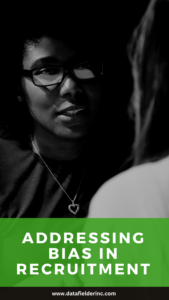
Imagine working in a workplace where co-workers from diverse backgrounds collaborate, innovate, and thrive together. Allowing achievement in a harmonious and diverse environment starts with addressing bias in hiring, creating a fair and inclusive recruitment landscape.
Dive in, as we explore the critical importance of this mission, how it can be achieved, and why it matters.
Why Addressing Bias in Hiring Matters:
Bias in the workplace is a pervasive issue that affects both organizations and individuals. It leads to exclusion, discrimination, and a lack of diversity, which ultimately hinders creativity and innovation. By addressing bias in hiring, we pave the way for a more inclusive, equitable, and successful work environment.
Identifying Bias in Hiring
One of the first steps in addressing bias is recognizing it. Bias can manifest in various forms, such as gender bias, racial bias, age bias, and more. It may be unconscious or implicit, making it challenging to detect. Tools and training that focus on bias awareness can help organizations pinpoint areas of concern.
Benefits of a Diverse Workforce
Diversity in the workplace is not just a buzzword; it brings tangible benefits. A diverse workforce brings together individuals with unique perspectives, backgrounds, and experiences, fostering innovation and creativity. Studies have shown that diverse teams outperform homogeneous ones in problem-solving and decision-making.
Strategies for Bias-Free Hiring
- Implement Blind Recruitment: Remove identifying information such as names, genders, and ages from application materials to ensure a focus on qualifications.
- Standardize Interviews: Use a consistent set of questions and evaluation criteria for all candidates to reduce subjectivity.
- Offer Bias Training: Educate employees about unconscious bias and its impact on hiring decisions.
- Establish Diverse Hiring Panels: Encourage diversity among interviewers to ensure a broader perspective.
- Leverage Technology: Employ AI and data analytics to identify and address bias in hiring processes.
A Real-Life Success
A well known home renovation supplier, in partnership with DataFielder, embarked on a journey to address bias in their hiring practices. By implementing blind recruitment and standardized interviews, they achieved a 30% increase in diverse hires within three months. This success story not only exemplifies the transformative power of addressing bias, but it shows you what can be done.
What If I Don’t See Bias in My Hiring Process?
It’s important to note that bias can be subtle and often goes unnoticed. Even well-intentioned individuals may unknowingly harbor biases. Regularly evaluating your hiring process and providing bias training to your team can help uncover hidden biases and rectify them.
Applying Bias-Free Hiring Everywhere
Bias in hiring can occur at any stage of the recruitment process, from job postings and initial screenings to interviews and final selections. To create a truly inclusive recruitment landscape, organizations must address bias at every step.
What Steps Will You Take?
What steps will you take to address bias in your hiring process and foster diversity in your workplace? Join us in creating a fair and inclusive recruitment landscape that benefits both organizations and individuals.
Addressing bias in hiring is not only the right thing to do; it’s a strategic imperative. By recognizing the importance of a diverse workforce and implementing bias-free hiring practices, organizations can unlock innovation, creativity, and success. If you’re looking to make your workplace more inclusive or seeking diverse job candidates, connect with DataFielder today and be part of the change. Together, we can create a brighter and more equitable future.




